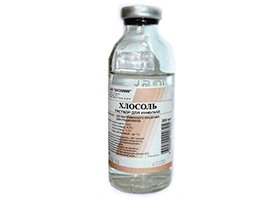
All iLive content is medically reviewed or fact checked to ensure as much factual accuracy as possible.
We have strict sourcing guidelines and only link to reputable media sites, academic research institutions and, whenever possible, medically peer reviewed studies. Note that the numbers in parentheses ([1], [2], etc.) are clickable links to these studies.
If you feel that any of our content is inaccurate, out-of-date, or otherwise questionable, please select it and press Ctrl + Enter.
Chlosol
Medical expert of the article
Last reviewed: 03.07.2025

Chlosol is a medicinal product with a combined composition and a rehydrating effect on the human body.
ATC classification
Active ingredients
Pharmacological group
Pharmachologic effect
Indications Chlosoli
The medication is indicated for use in the following pathological conditions:
- Cholera Inaba (El Tor);
- Acute amebiasis;
- Foodborne toxic infection (to reduce or eliminate symptoms of dehydration and poisoning).
 [ 1 ]
[ 1 ]
Release form
The medicine is available in bottles of different volumes: fifty, one hundred, two hundred fifty and five hundred milliliters.
Pharmacodynamics
Due to its combined composition, Khlosol is a saline solution that is characterized by hemodynamic and detoxifying effects. That is why it is actively used in inpatient treatment for detoxification and rehydration.
The main effects of the drug are:
- Preventing the formation of metabolic acidosis and blood thickening;
- Reduction of hypovolemia;
- Increased frequency of urination;
- Improving blood circulation in capillaries.
Pharmacokinetics
Due to the fact that Chlosol has crystalloids with low molecular weight, it easily penetrates through the capillary walls and therefore is actively released into the interstitial space, from the vascular bed. Due to this, the amount of fluid that circulates in the vessels is increased by the solution for a short period of time.
Dosing and administration
Chlosol solution can be used intravenously by jet or drip.
Jet administration, with subsequent transition to drip administration, is indicated in the case of:
- Decompensated metabolic acidosis;
- Lack of urination;
- Inadequate capillary perfusion (reduced blood supply to organs and tissues through the smallest vessels);
- Severe diseases:
- Hypovolemic shock, occurring against the background of a sharp decrease in the volume of circulating blood;
- Infectious toxic shock, which occurs due to the entry of unhealthy waste products of microorganisms into the blood.
Only drip administration of Chlosol is possible in the following cases:
- Intoxication;
- Poisoning;
- Dehydration;
- Metabolic acidosis;
- Decreased amount of urine excreted.
In urgent cases, such as urgent restoration of water balance in hypovolemic shock, a solution of Chlosol heated to 36-38C should be administered by jet injection within one to three hours. In this case, the volume of the solution in the first hour is calculated based on the amount that corresponds to seven to ten percent of the patient's weight. Then, after replacing the jet injection with drip injection, the solution is administered at a rate of 40-120 drops per minute for one to two days.
The medication can only be used under the control of these tests.
The volume of the administered solution must be consistent with the volume of fluid lost with vomit, feces, urine and sweat. For control, the volumes of lost and administered fluid are compared every six hours (four times a day).
Use Chlosoli during pregnancy
There is no information on the possibility of using this drug during breastfeeding and gestation.
Contraindications
Chlosol should not be used in treatment if the patient has at least one of the following pathologies in their medical history:
- hypersensitivity to any component of the drug;
- elevated levels of potassium in the blood;
- alkalosis;
- CRF (chronic renal failure);
- if the patient has any contraindication to the intake of large amounts of fluid.
Side effects Chlosoli
During the use of this medicine, the patient may experience some undesirable effects. For example, tachycardia, edema, chills, increased serum potassium levels.
 [ 8 ]
[ 8 ]
Overdose
If a large volume of Chlosol solution is used to treat a patient, the patient's blood potassium level may increase due to an overdose. To correct this condition, the patient needs to be given a Disol solution intravenously.
Interactions with other drugs
Chlosol should not be prescribed together with potassium solutions and potassium-sparing diuretics.
 [ 11 ]
[ 11 ]
Storage conditions
The medicine does not require a special temperature regime. The main thing is not to freeze it and store it in a place protected from light.
Special instructions
Reviews
Since Khlosol is used exclusively in hospital settings for intoxication for rehydration against the background of acute dehydration, there are no reviews about it in the information space.
Shelf life
Do not use the medicine after the expiration date stated on the package.
Manufacturer
Attention!
To simplify the perception of information, this instruction for use of the drug "Chlosol" translated and presented in a special form on the basis of the official instructions for medical use of the drug. Before use read the annotation that came directly to medicines.
Description provided for informational purposes and is not a guide to self-healing. The need for this drug, the purpose of the treatment regimen, methods and dose of the drug is determined solely by the attending physician. Self-medication is dangerous for your health.

